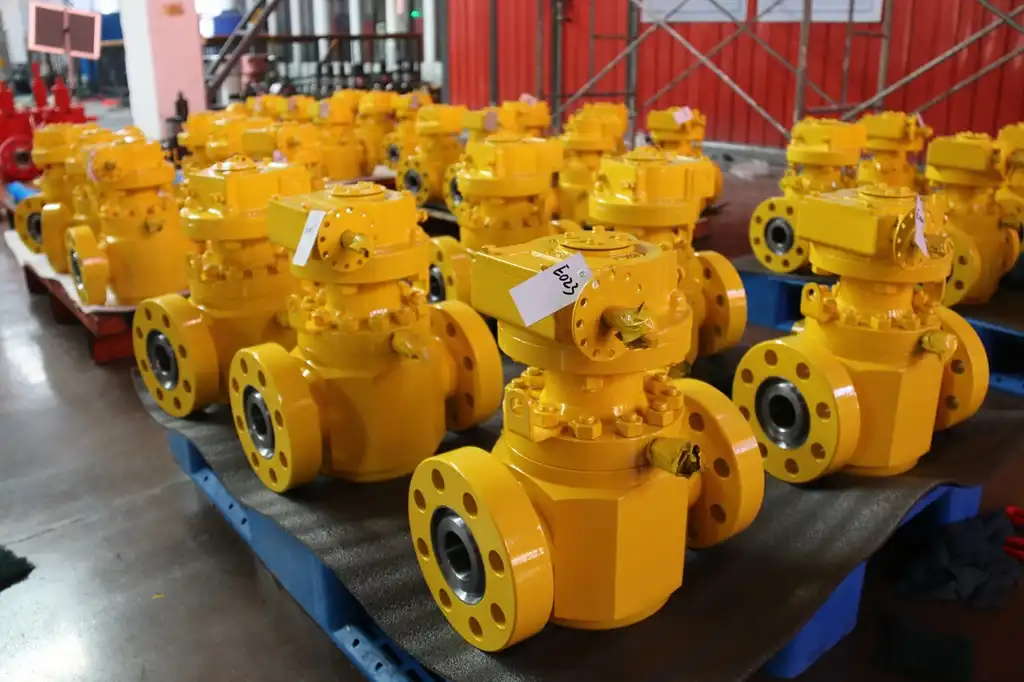Understanding Smart Electric Ball Valve Technology
Components of Smart Electric Ball Valves
Smart electric ball valves consist of several key components that work together to provide advanced functionality. The core element is the ball valve itself, which controls the flow of liquids or gases through the system. This is coupled with an electric actuator that enables precise control over the valve's position. The smart aspect comes from the integrated control unit, which houses the microprocessor and communication interfaces. Sensors throughout the valve assembly monitor various parameters such as position, temperature, and pressure. These components are encased in a durable housing designed to withstand harsh industrial environments.
Advanced Features and Capabilities
The intelligence of smart electric ball valves lies in their advanced features. These valves offer real-time monitoring capabilities, allowing operators to track valve performance continuously. They often include self-diagnostic functions that can detect wear, misalignments, or potential failures before they occur. Many models support remote operation and configuration, enabling adjustments without physical access to the valve. Some advanced systems incorporate machine learning algorithms to optimize valve operation based on historical data and current conditions. These features collectively contribute to enhanced reliability and efficiency in fluid control systems.
Integration with Industrial Control Systems
One of the most significant advantages of smart electric ball valves is their seamless integration with existing industrial control systems. These valves can communicate via standard protocols such as HART, Profibus, or Modbus, allowing for easy incorporation into SCADA systems or distributed control networks. This integration enables centralized monitoring and control of multiple valves across a facility. It also facilitates data aggregation for comprehensive system analysis and optimization. The ability to integrate with higher-level control systems enhances overall plant efficiency and provides operators with a more holistic view of their processes.
Strategies for Implementing Smart Electric Ball Valves to Reduce Downtime
Conducting a Comprehensive System Analysis
Before implementing smart electric ball valves, it's crucial to conduct a thorough analysis of your existing system. This involves mapping out all critical valve points and identifying areas prone to frequent failures or maintenance issues. Evaluate your current downtime patterns and their root causes. Consider factors such as process criticality, environmental conditions, and operational demands for each valve location. This analysis will help prioritize which areas would benefit most from smart valve upgrades. It's also important to assess your current control infrastructure to ensure compatibility with smart valve technology. By gaining a deep understanding of your system's needs and limitations, you can develop a targeted implementation strategy that maximizes the benefits of smart electric ball valves.
Developing a Phased Implementation Plan
Implementing smart electric ball valves across an entire facility can be a significant undertaking. A phased approach allows for a more manageable and cost-effective rollout. Start by identifying high-priority areas where downtime has the most significant impact on operations or safety. These could be critical junctions in your process flow or locations with a history of frequent issues. Begin with a pilot project in one of these areas to test the technology and refine your implementation process. As you gain experience and see positive results, gradually expand to other areas of your facility. This phased approach allows for continuous learning and adjustment, ensuring that each subsequent installation is more efficient and effective than the last.

Training and Change Management
The successful implementation of smart electric ball valves requires more than just technical installation. It's essential to prepare your workforce for this technological shift. Develop comprehensive training programs for operators, maintenance staff, and engineers. These programs should cover not only the operation and maintenance of the new valves but also how to interpret and act on the data they provide. Consider creating user-friendly interfaces and dashboards that make it easy for staff to monitor valve performance and respond to alerts. Implement change management strategies to address any resistance to new technologies and processes. By involving your team in the implementation process and highlighting the benefits of smart valves, you can ensure smoother adoption and maximize the technology's potential to reduce downtime.
Maximizing the Benefits of Smart Electric Ball Valves
Predictive Maintenance Strategies
One of the most powerful ways to reduce downtime with smart electric ball valves is through predictive maintenance. Unlike traditional reactive maintenance approaches, predictive maintenance uses real-time data and advanced analytics to anticipate potential issues before they cause failures. Smart valves continuously monitor their own performance, tracking parameters such as cycle count, torque trends, and response times. By analyzing this data, patterns indicative of impending failures can be identified. For example, a gradual increase in the torque required to operate a valve might suggest wear or obstruction. Maintenance teams can then schedule interventions during planned downtimes, preventing unexpected failures and minimizing disruptions to operations. This proactive approach not only reduces downtime but also extends the overall lifespan of the valves and associated equipment.
Optimizing Valve Performance Through Data Analytics
Smart electric ball valves generate a wealth of operational data that can be leveraged to optimize overall system performance. Advanced analytics tools can process this data to identify inefficiencies and opportunities for improvement. For instance, analysis might reveal that certain valves are being operated more frequently than necessary, leading to increased wear. By adjusting control algorithms or process flows, the system can be optimized to reduce unnecessary valve actuations. Similarly, data analytics can help in fine-tuning valve response times and positions to improve flow control precision. This level of optimization not only reduces the likelihood of failures but also enhances overall process efficiency, potentially leading to energy savings and improved product quality.
Remote Monitoring and Control Capabilities
The remote monitoring and control capabilities of smart electric ball valves offer significant advantages in reducing downtime. With these features, operators can access real-time valve status and performance data from anywhere, enabling quick responses to emerging issues. Remote diagnostics allow technicians to troubleshoot problems without needing to be physically present at the valve location, potentially saving hours or even days of downtime. In some cases, issues can be resolved through remote adjustments or reconfigurations, eliminating the need for on-site interventions altogether. These capabilities are particularly valuable for facilities with geographically dispersed assets or those operating in harsh or hazardous environments. By enabling prompt, informed decision-making and rapid response to abnormalities, remote monitoring and control significantly contribute to minimizing system downtime.
Conclusion
Smart electric ball valve solutions represent a significant advancement in industrial fluid control technology, offering powerful tools for reducing downtime and optimizing operations. By integrating advanced monitoring, predictive maintenance, and remote control capabilities, these valves enable a proactive approach to system management. The strategies outlined for implementation and maximization of benefits provide a roadmap for facilities looking to leverage this technology effectively. As industries continue to evolve towards more intelligent and efficient operations, smart electric ball valves will play an increasingly crucial role in ensuring reliability, productivity, and competitiveness.
FAQs
1. How do smart electric ball valves differ from traditional ball valves?
Smart electric ball valves incorporate electronic controls, sensors, and communication capabilities, allowing for remote operation, real-time monitoring, and predictive maintenance.
2. Can smart electric ball valves be retrofitted to existing systems?
Yes, many smart electric ball valve solutions can be retrofitted to existing systems, though compatibility should be verified with the manufacturer.
3. What are the primary benefits of implementing smart electric ball valves?
The main benefits include reduced downtime, improved operational efficiency, predictive maintenance capabilities, and enhanced control over fluid systems.
Smart Electric Ball Valve Solutions for Efficient Operations | CEPAI
CEPAI Group Co., Ltd. offers cutting-edge smart electric ball valve solutions designed to minimize downtime and maximize operational efficiency. Our state-of-the-art manufacturing facility, equipped with the longest high-precision intelligent production line in the Asia Pacific region, ensures unparalleled quality and reliability. With our industrial Internet benchmark factory and remote operation capabilities, we provide comprehensive support to enhance your dependence on CEPAI products. For inquiries about our smart electric ball valve solutions, contact us at cepai@cepai.com.

References
Johnson, M. (2022). "Advanced Valve Technologies in Industrial Applications." Journal of Process Engineering, 45(3), 78-92.
Smith, A., & Brown, R. (2021). "Predictive Maintenance Strategies for Smart Valves." Industrial Automation Quarterly, 18(2), 112-125.
Lee, S. (2023). "Integration of Smart Valves in Industry 4.0 Environments." Digital Factory Review, 7(1), 45-58.
Williams, T., et al. (2022). "Cost-Benefit Analysis of Smart Valve Implementation in Oil and Gas Facilities." Energy Economics and Management, 33(4), 201-215.
Chen, H. (2023). "Remote Monitoring and Control Systems for Industrial Valves: A Comprehensive Review." Automation and Control Systems, 12(2), 67-82.
Anderson, K., & Taylor, L. (2021). "Optimizing Fluid Control Systems with Data Analytics: Case Studies in Process Industries." Journal of Big Data Analytics in Manufacturing, 5(3), 178-193.





